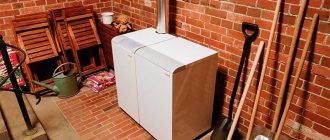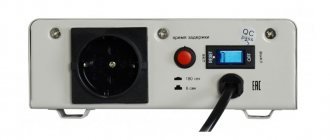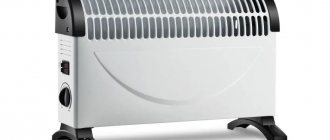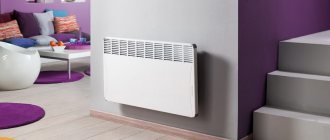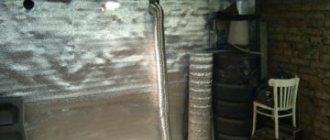- What determines the cost of heating a house?
- The most accessible and cheapest type of fuel
- Types of heating devices
- Electrical
- Heat guns
- Oil radiators
- Electric convectors
- Infrared heater
- Ceramic
- Convectors
- Infrared
- Catalytic
- Solar collectors
With the onset of the autumn-winter period, summer residents are faced with a pressing question: how to heat the garden house? The choice of different devices is huge. But how not to get lost in all the diversity? How to choose an effective device specifically for your case? Let's figure it out together and choose the best option for heating a small country house from 18 to 36 square meters, because there are most of these types of buildings.
Spoiler for the impatient. The most profitable method is combined. The main source is a wood stove or fireplace stove (read our rating of stoves for a country house). And after the dacha has warmed up, convectors are connected to maintain the temperature regime. So, in order.
The choice of heater is made based on the following conditions:
- Permanent residence in a holiday village or visiting on Sundays and holidays;
- Availability of communications
- Is electricity and gas supplied to the dacha?
- Is the device intended for heating only or is water heating also required?
- Economic and operational indicators of devices.
What determines the choice of heating method for a summer house?
As a rule, a summer house is an object of periodic use, especially in winter. People travel outside the city to relax and enjoy clean air, and some even live in their dachas permanently.
The country houses themselves vary greatly - from light and poorly insulated to real cottages with several floors.
When choosing heating options for your dacha, you need to consider a number of important points:
- frequency and duration of stay in winter;
- what energy resources are available and will cost the least;
- distance from populated areas and organization of security of the holiday village;
- need for hot water supply.
In each case there may be additional nuances. For example, a dacha is combined with a bathhouse and it is more correct to provide one heat source for them. Or you have a large family, then you need to maintain a higher temperature in the rooms. The nuances must be taken into account when choosing a heating method.
Particular attention should be paid to the issue of security; this is one of the features that distinguishes a dacha from an ordinary private house. Unfortunately, security in holiday villages is often poorly organized or non-existent, and burglaries are not uncommon. Imagine that you bought and installed expensive electric convectors, and they were stolen after you left. It turns out that the massiveness of the heat source plays an important role, so that it cannot be dragged away. These include heavy boilers, brick fireplaces, stoves, and so on.
Heating system requirements
Depending on individual conditions, different requirements may be imposed on the heating of a country house, but there are also general ones that will always be relevant:
- quick heating of rooms;
- the heating system must use available energy carriers, possibly several;
- reasonable cost of equipment and installation work;
- efficiency and economy;
- the ability to function in periodic mode and withstand frost during downtime without consequences.
In order to make it easier for you to choose the optimal method of heating your dacha, we will consider real options for heating with different energy sources and how well they meet the listed requirements. Then you can add your wishes to them and determine which method is better.
Electricity
At the moment, most holiday villages are not gasified, but electricity is available almost everywhere. Accordingly, electric autonomous heating without gas is of great interest and deserves consideration as one of the most affordable options. Its advantages are speed and low cost of installation, relatively low cost of equipment and reliability in terms of frequency of operation.
As for economy and efficiency, any electric heaters take first place in this regard. Their efficiency is 98-99%, which is higher than when burning any type of fuel.
The modern market offers a wide selection of means for heating a dacha with electricity. For well-guarded dachas or those where residents stay permanently, any of them are suitable:
- convectors and fan heaters;
- oil radiators;
- infrared heating systems;
- cable and film heated floors;
- water heating with electric boiler.
Electric fan heaters and convectors warm up the room the fastest, at least according to human sensations. Oil radiators take a little longer, but they also take longer to cool down. All these devices heat the air in the house and do not require installation, except for wall-mounted convectors. This household appliance can easily withstand the cold, and its maintenance comes down to periodic cleaning.
In an apartment, the light weight and size of an electric heater are an important advantage, while in an unguarded dacha this is a disadvantage; the devices are easy to steal. In addition, such electric heating will not provide the house with hot water, and for a certain part of people it causes discomfort and affects well-being.
Infrared heating devices have the same disadvantages, only the higher cost of equipment and installation work must be added to them. The exception is portable infrared heaters, but they feel like they warm up rooms too slowly. To feel the heat emanating from them, you need to be in the radiator’s coverage area. On the other hand, infrared heating does not have a negative impact on human well-being.
What to look for when choosing?
- The most important part of the convector is the heating element. It is wiser to give preference to a monoblock design, the lifespan of which is 10–25 years.
- Electrical wires going to the heating element should not pass through the heating zone and bend over the edge of the metal sheet.
- The power button, located at the bottom of the case, is not very convenient; it is better if it is at the top, then you don’t have to bend down to control the device. The same goes for the thermostat.
- The thickness of the walls plays an important role - the thicker it is, the less the risk of damaging the heater in case of an accidental impact.
- Finally, it is useful to pay attention to the design of the brackets with which the device is fixed to the wall. Some models have movable fasteners, allowing you to easily remove them if necessary or tilt them away from the wall if you need to wash the back panel.
Read more in the material “Fast Heat”.
2
Stationary heating means with electricity
Electric cable or film floors are perfect for heating a dacha. True, you will have to incur costs for the purchase of heating elements and installation under the floor covering or in the screed. But such equipment starts easily from subzero temperatures, and it is also impossible to steal.
Disadvantages are long-term heating of the premises and the inability to heat water; this requires an electric boiler or a separate water heater.
The most convenient and functional traditional heating method is a water system with an electric boiler as a heat source. Its negative aspects are significant financial costs for installing the system and a long heating time for the building. In addition, during your absence, the water system is in danger of defrosting. But by installing a small indirect heating boiler in addition to the boiler, you can get hot water for household needs at your dacha.
To avoid defrosting, you need to purchase antifreeze, and use it to prepare and pour liquid into the heating system.
Important disadvantages of electric heating in general are the high electricity tariff and the limited power consumption limit. Regarding various heaters, you could see for yourself that they all have pros and cons; the appropriate option is selected individually.
Heaters with heat storage blocks
There are heating devices that can accumulate heat at night, when electricity is relatively inexpensive, and release it during the day. The so-called heat accumulator is a heating device with a steel body, which contains storage blocks heated by a heating element. These can be magnesite bricks, soapstone chloride crushed stone and soapstone chloride blocks. The difference is not fundamental. Thanks to reliable core insulation, the heat accumulator does not waste the accumulated energy. It is almost entirely spent on heating.
Diagram of a dynamic type heat storage device (with a fan)
When the temperature of the storage unit rises to 650-700ºC, the pressure sensor blocks the operation of the heating element, and the device goes into sleep mode, heating the room due to the accumulated heat.
This is the operating principle of static
heat accumulator.
The second type of this heater - dynamic
- has an additional technical unit. We are talking about a fan that enhances the heating effect. However, the principle of its operation is worth considering in more detail.
Each dynamic heat accumulator is equipped with a thermostat on which a comfortable temperature is set. As soon as it decreases (this is monitored by a special sensor), the fans located inside the battery pack turn on. They pass air through channels between the bricks and direct it into the room. To ensure that the house is not too hot, a built-in bimetallic sensor monitors the air flow through a special damper. The air temperature at the outlet of the device does not exceed 70ºС. The power consumption of the device is 1.6–7 kW.
During operation, the body of the device practically does not heat up, which eliminates the burning of dust and burns from accidental touch.
Static (left) and dynamic (right) heat accumulators
Despite the fact that the heat accumulator has a relatively simple design, manufacturers provide it with various useful options. Thanks to the thermostat mentioned above, you can adjust the heating mode based on the preferences of a particular user. The most advanced devices allow you to program the “weather in the house” for a week in advance. And thanks to the specially shaped blades, the fans do not get on your nerves. The noise level it produces does not exceed 30 dB.
However, the financial issue is much more important to the user. As practice shows, a heat accumulator can reduce heating costs by up to 4 times compared to conventional electric heaters.
Continuing the topic of advantages, it is worth noting the durability of the device. According to manufacturers, the heat accumulator will last at least 30 years.
Despite the presence of a massive storage unit, the dimensions of the heat accumulator do not exceed the dimensions of conventional water radiators
More details in the article “Savings part”.
3
Gas
Of course, gas heating is one of the most convenient for a dacha; there will be quick heating and hot water. The efficiency of the installations is high, reaching 92%. But the price of the resource varies greatly in different countries. In the Russian Federation, heating a dacha with gas is realistic, in Belarus or Ukraine it is already problematic, where its price is much higher. And gas mains are not laid in dacha cooperatives, with rare exceptions.
When the house is gasified, heating in the dacha can be done in two ways:
- install a double-circuit boiler and mount pipelines with radiators;
- install gas convectors in the premises, thereby organizing air heating.
The main difficulty when installing gas heating is obtaining permission to connect to the main line. Carrying out the procedure in relation to a country house is not economically feasible. The solution is to heat with liquefied gas, but this only makes sense in Russia, where the price of fuel is acceptable.
Video description
In our video we’ll talk about heating in a private country house.
Our guest is the author and presenter of the Teplo-Voda channel Vladimir Sukhorukov: Modern boilers included in a home heating project are equipped with an electronic system that is responsible for the operation and functionality of the device. In addition to the boiler, the project includes wiring from pipes, radiators, pumps and other elements.
They can be easily bought in specialized stores, their assortment is large, the materials from which they are made can be very different, and so can the “sophistication” of control systems. They differ from each other in power, properties, brand ratings, quality and cost.
Components for heating systems are made from various materials Source nts-sk.ru
Stove and solid fuel boiler
Heating your dacha with wood is the easiest thing to do if you are not in the desert. There is no need to obtain any permits, and it is impossible to drag away bulky equipment. Both the stove and the boiler feel normal at low temperatures, this is important for periodic use. An exception is boilers equipped with electronic control units; this modern technology may fail when started in cold weather. So it is better to organize heating of a country house with a solid fuel boiler of a simple design, without electronics. The efficiency of such units does not exceed 75%.
The heat generator, as in the case of gas, will have to be connected to a water heating system, filling it with antifreeze. At the initial stage, count on a significant investment of money, since equipment, piping elements and heating devices with pipelines will not be cheap. When the house is small, this is irrational; it is better to organize stove heating. The choice of metal stoves is extremely wide; you can choose the right one both for money and for every taste.
Metal and brick stoves with water heating quickly heat up themselves and warm up the room; in addition, they can supply heat to radiators in adjacent rooms, as well as prepare water for hot water supply. But the efficiency of the furnaces is low - about 60%.
Building a brick stove is not always expensive; here you need to choose a successful design, for example, build a Dutch stove or a small Swedish stove. It can include a hob for cooking, an oven and a water tank. For aesthetes, we can advise you to build a fireplace out of brick or purchase a ready-made metal one.
Despite all their advantages, stoves and fireplaces require chimneys and also take up a lot of space. A solid fuel boiler can be taken outside into an extension, but the stove will take up useful space in the house.
Rules for the location of batteries in the house
In order for the system to work properly, installation rules must be strictly followed. Although the installation technology is not complicated, it has its own nuances, so the work must be carried out by specialists.
Important! If radiators are installed incorrectly, they are not covered by the warranty.
In order to avoid heat loss and uneven heating of the room, when installing devices it is necessary to observe indentations and choose the correct location:
- The most suitable option for the battery is considered to be a place under the window, i.e. where the heat loss is the most significant. The radiator width must be at least 70% of the window width. Mounted clearly in the middle.
- Leave at least 10 cm from the battery to the windowsill, as well as to the floor. The optimal distance between the floor and the radiator is 12 cm. It is not recommended to leave more than 15 cm.
- The battery is fixed at a distance of 5 cm from the wall.
- You can stick heat-reflecting material behind the radiator - then some of the heat will not go into the wall, but will return to the room.
- If the radiator is planned to be placed not under the window sill, but on the wall, then the distance between them should be at least 20 mm.
Calculation of the number of sections
It is not necessary to look for the most expensive heating devices to make the room comfortable. The main thing is to correctly calculate the number of sections. If the rooms are standard, then this greatly simplifies the calculations.
Often they resort to calculations based on the volume of space because they are simple, but at the same time give fairly accurate results.
- 1 m³ requires 41 W of power. If good double-glazed windows are installed and heat loss is minimal, then the indicator drops to 34 W.
- Room volume (m³) = area (m²) × height (m).
- Required heating power for the entire room (W) = room volume (m³) × 41 W (or 34 W).
- In the technical data sheets of devices, manufacturers indicate the heat transfer of one section.
- The total power (the value calculated in point 3) must be divided by the heat transfer of one section. The resulting number is the number of sections.
For example, the required thermal power is 2890 W, and the heat output of one section is 170 W. Then for this room you need to purchase 17 sections.
If the room is non-standard, the calculations become more complicated. To calculate the total power, the features of double-glazed windows (double or triple), thermal insulation parameters of the walls, the ratio of the sizes of windows and floors, ceiling heights and other parameters are taken into account. Designers calculate all this using specialized software.
Diesel fuel
This case is appropriate if the owner of the dacha no longer has any energy resources at his disposal. This really happens, diesel heating comes to the rescue when there is no gas, the limit on electricity consumption is too small, and transporting firewood is too far or expensive. The cost of the equipment is comparable to gas, as is the efficiency (92%), only connection permits are not required. This is where the positive aspects end, the reason is the price of diesel fuel, the operation of a diesel boiler cannot be called cheap.
To heat a dacha with diesel fuel, in addition to the boiler, you still need the same water heating system and radiators filled with antifreeze. The water heating function is also available if you purchase a dual-circuit heat generator. A warning is appropriate here: it is better to take the unit with a minimum of electronics, which can fail at subzero temperatures.
For those who like to do the heating installation themselves, there is an alternative: a homemade boiler using waste oil. You can make it yourself, spending a minimum of money. The game is worth the candle, provided that such fuel is available to you.
Recommendations on how to save on heating a country house
It has been observed that heat leaks affect the speed and efficiency of heating rooms. Up to 20% of the heat usually escapes through old wooden double-glazed windows. Through cold walls - up to 40%, through doors - up to 20%, through the floor - 10%. Accordingly, if before the onset of cold weather you fix leaks and insulate the walls, then within an hour you will be able to feel in a country house just like in a city apartment.
And further. The most economical heating for a summer house in terms of fuel consumption is gas . Therefore, if it is possible to connect to the highway, then it is better to choose it as a priority.
